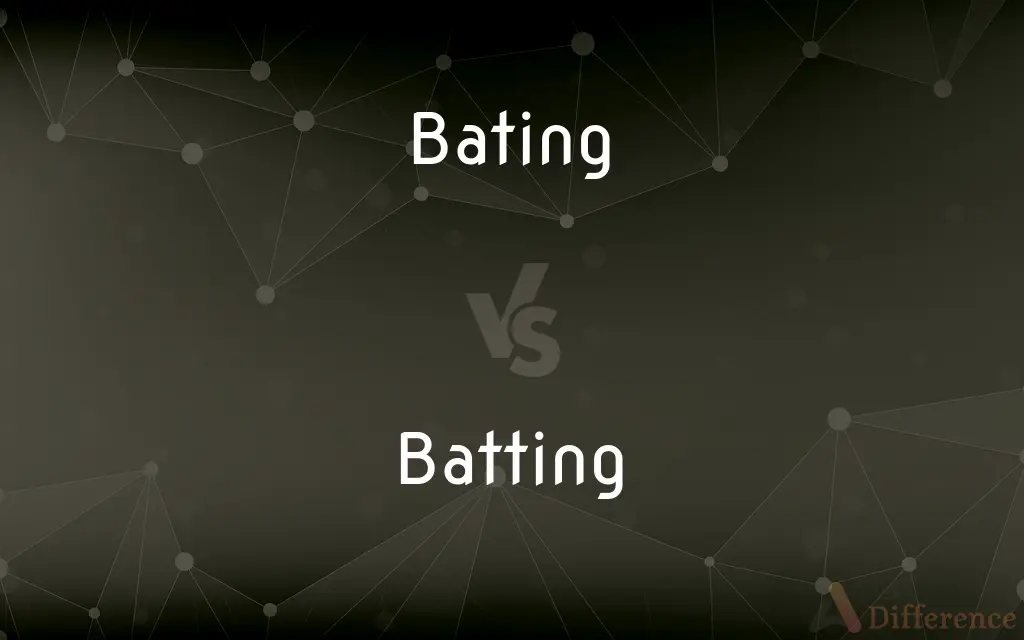Bating vs. Batting — What's the Difference?
Edited by Tayyaba Rehman — By Maham Liaqat — Updated on March 29, 2024
Bating is a process involving the treatment of leather to remove lime and soften it, while batting refers to the act of hitting with a bat, especially in sports like baseball or cricket.

Difference Between Bating and Batting
Table of Contents
ADVERTISEMENT
Key Differences
Bating is a specific term used in the leather industry, describing a stage in leather processing where hides are treated with enzymes to remove lime and soften the leather, preparing it for dyeing and finishing. This process is crucial for ensuring the leather's flexibility and quality. On the other hand, batting is a term widely used in sports, particularly in baseball and cricket, where it denotes the action of hitting a ball with a bat as part of the game. Batting requires skill, coordination, and timing to effectively strike the ball and contribute to the team's performance.
While bating is a chemical process that involves no physical movement, batting is a physical activity that requires practice, strength, and technique. Bating plays a significant role in the quality of the final leather product, impacting its texture, durability, and appearance. Conversely, batting is a critical skill in certain sports, influencing the outcome of a game and requiring a combination of physical and mental aptitude.
Bating is performed during the manufacturing phase and is one of many steps in leather production, a process unknown to most outside the leather industry. Batting, however, is a visible and often celebrated aspect of sports, watched and practiced by millions around the world. It has rules, techniques, and styles that vary depending on the sport and the player's approach.
The effectiveness of bating is measured by the quality and properties of the treated leather, such as its softness and how well it accepts dyes. The success of batting, however, is measured by the player's ability to hit the ball effectively, contributing to their team's scoring and strategic advantage in a game.
Comparison Chart
Definition
A leather treatment process to remove lime and soften.
The action of hitting with a bat in sports.
ADVERTISEMENT
Field
Leather manufacturing.
Sports (e.g., baseball, cricket).
Purpose
To prepare leather for dyeing and finishing.
To score runs or points by hitting a ball.
Activity Type
Chemical process.
Physical and skill-based activity.
Required Skills
Knowledge of chemical treatments and leather.
Physical coordination, timing, and sportsmanship.
Measurement of Success
Quality and texture of leather.
Effectiveness in hitting the ball and scoring.
Compare with Definitions
Bating
Bating involves soaking leather in enzymes to ensure it becomes supple.
Treating cowhide with a bating solution to make soft leather for jackets.
Batting
Batting is a key skill in baseball.
A player hitting a home run during a crucial game moment.
Bating
It's a crucial step in leather preparation.
Bating hides to remove any remaining lime after deliming.
Batting
Practice improves batting performance.
Athletes spending hours in the batting cage to refine their swing.
Bating
The process adjusts leather's properties for further treatment.
Ensuring the leather is properly bated for even dye absorption.
Batting
Batting positions and styles vary among players.
A left-handed batter adjusting stance for better reach.
Bating
Bating affects the feel and durability of the final product.
Producing premium leather goods that are soft to the touch.
Batting
It involves strategy and technique.
Choosing the right moment to swing in cricket.
Bating
This technique has been used for centuries in leather making.
Traditional bating methods using natural enzymes.
Batting
Batting averages help measure a player's success.
Maintaining a high batting average as an indicator of skill and consistency.
Bating
To lessen the force or intensity of; moderate
"To his dying day he bated his breath a little when he told the story" (George Eliot). See Usage Note at bait1.
Batting
The act of one who bats.
Bating
To take away; subtract.
Batting
Cotton, wool, or synthetic fiber wadded into rolls or sheets, used for stuffing furniture and mattresses and for lining quilts.
Bating
To flap the wings wildly or frantically. Used of a falcon.
Batting
(sewing) Cotton, wool, silk or synthetic material used to stuff the inside of a mattress, quilt etc.
Bating
Present participle of bate
Batting
Special cotton for surgery.
Bating
Apart from; except.
Batting
The act of someone who bats.
The battings of her eyelashes
Bating
Of the moon, when it is waning.
Batting
The action of using a bat.
Bating
With the exception of; excepting.
We have little reason to think that they bring many ideas with them, bating some faint ideas of hunger and thirst.
Batting
Present participle of bat
Batting
The act of one who bats; the management of a bat in playing games of ball.
Batting
Cotton in sheets, prepared for use in making quilts, etc.; as, cotton batting.
Batting
(baseball) the batter's attempt to get on base
Batting
Stuffing made of rolls or sheets of cotton wool or synthetic fiber
Common Curiosities
What skills are needed for effective batting?
Skills include hand-eye coordination, timing, physical strength, and an understanding of the game's strategies.
Can bating be done at home?
Bating is a specialized process usually performed in industrial or professional settings due to the chemicals and knowledge required.
Why is batting important in sports?
Batting is crucial for scoring and competitive success in sports like baseball and cricket.
Are there different styles of batting?
Yes, batting styles can vary greatly among players, influenced by their physical attributes, training, and the specific requirements of their sport.
What is the purpose of bating in leather processing?
Bating softens leather and prepares it for subsequent dyeing and finishing processes.
Can the effectiveness of bating be measured?
Yes, by evaluating the leather's softness, flexibility, and how well it accepts dyes and finishes.
Is bating used in all leather products?
Most leather products undergo bating as part of their production to enhance quality and texture.
What impact does bating have on leather quality?
Proper bating significantly improves the leather's feel, durability, and appearance.
How does one improve their batting?
Through practice, coaching, and developing a deeper understanding of the sport's tactics and techniques.
What makes a successful batter in sports?
Success comes from a combination of physical skill, mental preparation, strategic thinking, and consistent performance.
Share Your Discovery

Previous Comparison
Composition vs. Constitution
Next Comparison
Divider vs. DivisorAuthor Spotlight
Written by
Maham LiaqatEdited by
Tayyaba RehmanTayyaba Rehman is a distinguished writer, currently serving as a primary contributor to askdifference.com. As a researcher in semantics and etymology, Tayyaba's passion for the complexity of languages and their distinctions has found a perfect home on the platform. Tayyaba delves into the intricacies of language, distinguishing between commonly confused words and phrases, thereby providing clarity for readers worldwide.













































